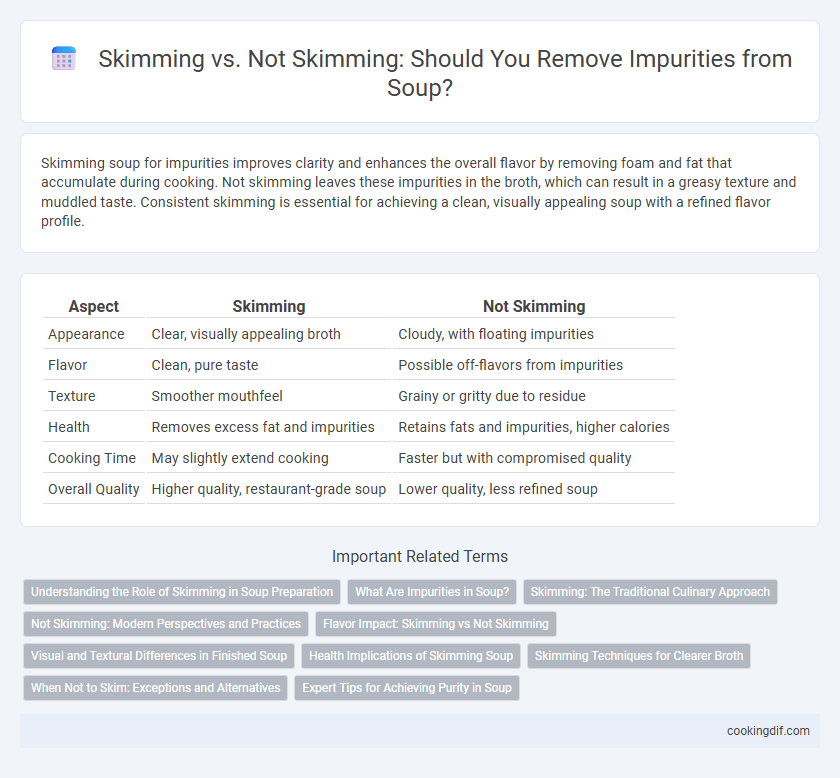Skimming soup for impurities improves clarity and enhances the overall flavor by removing foam and fat that accumulate during cooking. Not skimming leaves these impurities in the broth, which can result in a greasy texture and muddled taste. Consistent skimming is essential for achieving a clean, visually appealing soup with a refined flavor profile.
Table of Comparison
| Aspect | Skimming | Not Skimming |
|---|---|---|
| Appearance | Clear, visually appealing broth | Cloudy, with floating impurities |
| Flavor | Clean, pure taste | Possible off-flavors from impurities |
| Texture | Smoother mouthfeel | Grainy or gritty due to residue |
| Health | Removes excess fat and impurities | Retains fats and impurities, higher calories |
| Cooking Time | May slightly extend cooking | Faster but with compromised quality |
| Overall Quality | Higher quality, restaurant-grade soup | Lower quality, less refined soup |
Understanding the Role of Skimming in Soup Preparation
Skimming during soup preparation removes impurities and excess fat, leading to a clearer and cleaner broth that enhances flavor and presentation. Not skimming allows impurities to remain, which can result in a cloudy appearance and a potentially bitter taste due to the dissolved proteins and fats. Understanding the skimming process is essential for achieving a refined texture and balanced taste in consommes, broths, and clear soups.
What Are Impurities in Soup?
Impurities in soup refer to proteins, fats, and particulate matter released during cooking, which often float to the surface as foam or scum. Skimming these impurities enhances the soup's clarity and flavor by removing bitter or off-tasting elements. Leaving impurities unskimmed can result in a cloudy broth with a less refined taste and unpleasant texture.
Skimming: The Traditional Culinary Approach
Skimming soup during cooking removes impurities and excess fat, resulting in a clearer, cleaner broth with enhanced flavor and texture. This traditional culinary technique improves the soup's appearance and promotes a refined taste by preventing cloudy broth caused by proteins and particles. Professional chefs often prioritize skimming to ensure optimal quality and presentation in classic soups and stocks.
Not Skimming: Modern Perspectives and Practices
Not skimming impurities during soup preparation preserves essential nutrients and enhances natural flavors, aligning with modern culinary trends emphasizing wholesomeness and minimal processing. The presence of proteins and fats in the scum can contribute to a richer mouthfeel and improved nutritional value, supporting health-conscious eating habits. Current practices favor gentle simmering to clarify soups naturally without aggressive removal, promoting authentic texture and taste.
Flavor Impact: Skimming vs Not Skimming
Skimming impurities from soup removes proteins and fats that can create a cleaner, brighter broth, enhancing overall flavor clarity. Not skimming allows these elements to remain, often resulting in a richer but slightly cloudier and heavier taste profile. Chefs often balance skimming to achieve the desired flavor intensity while maintaining a visually appealing, clear soup.
Visual and Textural Differences in Finished Soup
Skimming impurities from soup creates a clearer broth with a smooth, refined texture, enhancing visual appeal and mouthfeel. Without skimming, the soup appears cloudier with a grainier texture due to suspended particles and fat. This visual and textural contrast significantly impacts the perceived quality and flavor intensity of the finished soup.
Health Implications of Skimming Soup
Skimming soup removes impurities and excess fat, reducing the presence of harmful substances and lowering calorie content, which can contribute to a healthier diet. Failing to skim leaves behind particles that may cause an unpleasant taste and impact digestion negatively. Regularly skimming broth enhances both the nutritional quality and overall health benefits of the soup.
Skimming Techniques for Clearer Broth
Skimming techniques for clearer broth involve gently removing impurities and foam from the surface during cooking to prevent cloudiness and off-flavors. Using a fine mesh skimmer or ladle, consistently skim the surface in the early stages of boiling, especially when making bone or meat-based soups. This practice ensures a cleaner, more visually appealing broth with enhanced taste and texture.
When Not to Skim: Exceptions and Alternatives
When not skimming impurities from soup, rich stocks like bone broth or ramen benefit from retaining the fat layer for enhanced flavor and mouthfeel. Alternatives to skimming include using a fat separator or chilling the broth to solidify and easily remove excess fat without disturbing the soup's depth. Exceptions apply to clear consommes and delicate broths where clarity and purity are essential, making skimming necessary.
Expert Tips for Achieving Purity in Soup
Skimming impurities from soup during cooking removes foam and fat, resulting in a cleaner, clearer broth with enhanced flavor and presentation. Experts recommend using a fine mesh skimmer periodically to gently lift off impurities without disturbing the simmering process, preserving the soup's delicate taste and texture. Avoiding skimming can cause a cloudy appearance and greasy mouthfeel, diminishing the overall quality of the soup.
Skimming vs Not Skimming for impurities Infographic

 cookingdif.com
cookingdif.com